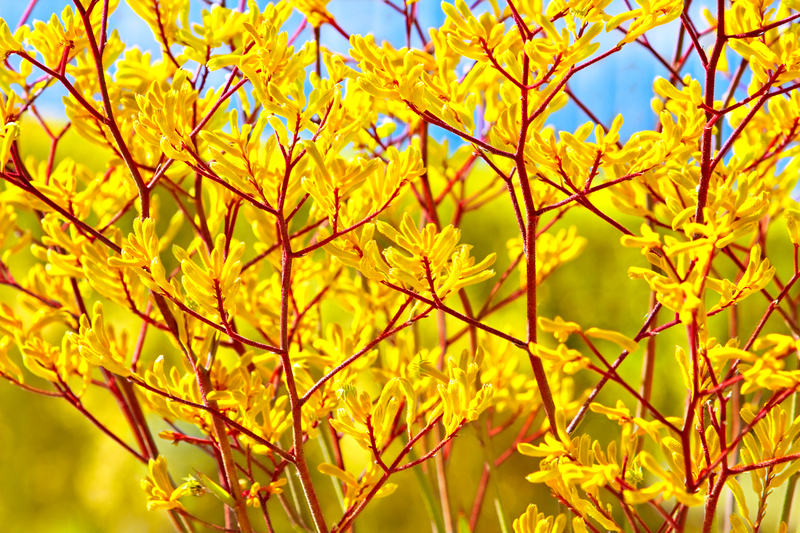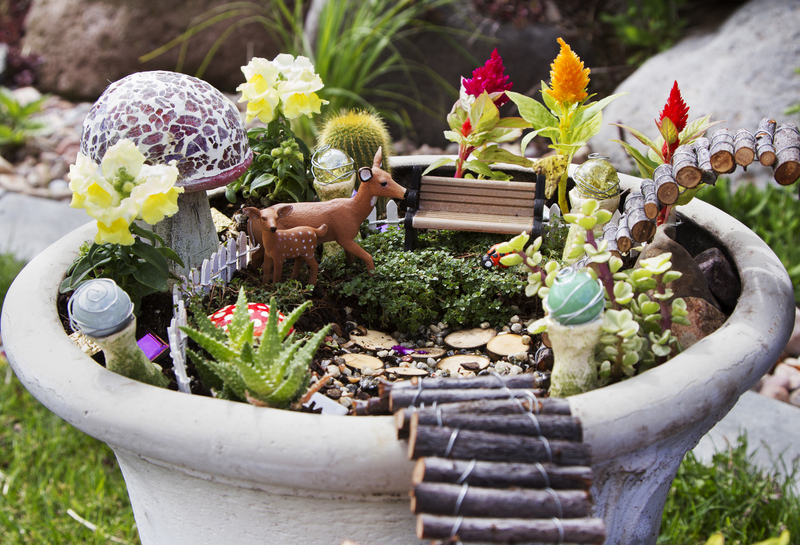Eco-gardening: A key in the climate change solution
Posted on 21/06/2025
Eco-Gardening: A Key in the Climate Change Solution
As the world grapples with the devastating impacts of climate change, many are searching for meaningful ways to make a difference. One such powerful and practical approach is eco-gardening. More than just a trend, eco-friendly gardening practices can be a crucial component in the global climate change solution.
Understanding Eco-Gardening
Eco-gardening--also known as sustainable gardening, green gardening, or environmental gardening--refers to a set of practices designed to nurture the environment while growing plants. It recognizes the interconnectedness of plant life, soil health, water resources, and local ecosystems. By building gardens that work with nature rather than against it, we contribute directly to climate checks and ecological restoration.
What Makes a Garden "Eco"?
- Minimizing chemical use: Reducing or eliminating chemical fertilizers and pesticides to protect soil, water, and beneficial organisms.
- Biodiversity: Planting a diverse mix of native plants and flowers to support local wildlife and pollinators.
- Water conservation: Installing rain barrels, choosing drought-tolerant plants, and designing rain gardens.
- Soil health: Composting organic matter, avoiding soil tillage, and practicing mulching to enrich soil naturally.
- Reducing carbon footprint: Selecting energy-efficient gardening tools and prioritizing manual methods.
- Eco-friendly garden design: Layouts that support natural drainage, wildlife corridors, and shaded areas for cooling.

Why Is Eco-Gardening Important for Climate Change?
Climate change is primarily driven by greenhouse gas emissions, deforestation, and unsustainable land use. Eco-friendly gardening strategies help address these threats in the following ways:
- Carbon Sequestration: Healthy plants and soils absorb carbon dioxide, removing it from the atmosphere.
- Biodiversity Conservation: Diverse gardens provide vital habitats for insects, birds, and small mammals, supporting ecosystem resilience.
- Mitigating Urban Heat: Vegetation cools surrounding areas, reducing the urban heat island effect.
- Water Management: Sustainable gardens improve rainwater infiltration, reduce flooding, and maintain cleaner waterways.
- Reducing Fossil Fuel Use: Hand tools and smart irrigation systems lower energy consumption compared to gas-powered alternatives.
The Science Behind Eco-Gardening and Climate Resilience
Research shows that sustainable gardening practices not only cut emissions but also help adapt to climate-related challenges. For example, planting trees, shrubs, and perennials improves soil structure, increases water retention, and buffers against temperature extremes. Eco-gardening solutions support both mitigation (reducing the causes of climate change) and adaptation (coping with its effects).
How Eco-Gardening Reduces Your Environmental Impact
Here's how an eco-friendly garden can make your home and community more resilient and climate-friendly:
- Composting: Recycling kitchen scraps and yard debris reduces methane emissions from landfills and returns nutrients to your soil.
- Choosing Native Plants: Native species require less water and maintenance, adapt better to local conditions, and foster local food webs.
- Using Mulch: Organic mulches conserve moisture, suppress weeds, and improve soil fertility--reducing the need for synthetic fertilizers.
- Rainwater Harvesting: Capturing rain in barrels or creating swales slashes reliance on potable water resources and prevents stormwater runoff.
- Minimizing Lawn Area: Lawns often require fertilizers, pesticides, and high water use; converting lawn to meadow or vegetable beds is more sustainable.
Case Study: The Community Climate Garden
In cities around the world, eco-gardening projects have revitalized vacant lots and urban parks:
- In London, school eco-gardens are teaching children about sustainable food and carbon storage.
- New York City's community gardens boast pollinator pathways and rainwater harvesting systems, making neighborhoods greener and cooler.
- Australian climate-smart gardens integrate native plants and edible landscapes that require minimal irrigation--even in drought.
These examples demonstrate the real-world power of eco-gardening to reduce climate risk and create vibrant, resilient urban spaces.
Practical Eco-Gardening Techniques for Every Gardener
No matter your skill level or the size of your garden, you can implement eco-gardening practices and play your part in climate action. Here are some of the most impactful methods:
1. Composting
- Collect food scraps and yard waste in a compost bin.
- Turn the pile regularly to aerate and speed up decomposition.
- Use finished compost to fertilize vegetables, flowers, and trees naturally.
Composting is a powerful way to shrink your carbon footprint and build soil health.
2. Plant Selection: Go Native and Diversify
- Research local native plants that thrive in your area.
- Mix perennials, shrubs, and groundcovers for year-round ecosystem support.
- Include pollinator-friendly plants such as lavender, asters, and milkweed.
3. Water-wise Gardening
- Install drip irrigation systems to minimize evaporation and runoff.
- Group plants with similar water needs together.
- Apply mulch to retain soil moisture.
- Capture rainwater for later use.
Conserving water is vital in a warming world with increased drought risk.
4. Organic Pest Management
- Encourage beneficial insects (ladybugs, lacewings) to control pests.
- Use barriers, row covers, and companion planting.
- Handpick pests instead of spraying chemicals.
Eco-friendly pest control helps protect birds, pollinators, and soil organisms essential for garden health.
5. Eco-friendly Lawn Alternatives
- Replace some or all of your lawn with groundcovers, wildflower meadows, or edible landscapes.
- If you keep a lawn, mow high and leave grass clippings to decompose naturally.
Less turfgrass means less water, fertilizer, and pollution.
The Bigger Picture: Eco-Gardening and Global Climate Goals
When multiplied across millions of households, environmental gardening has the potential to make a significant positive impact on the planet. Here's how:
- Sequestering Carbon: Collectively, garden soils could store millions of tons of additional carbon if managed sustainably.
- Restoring Local Ecosystems: Native gardens can reconnect fragmented habitats and strengthen wildlife corridors.
- Greener Cities: Urban eco-gardens reduce heat, air pollution, food miles, and stormwater flooding.
- Food Security: Growing fruits and vegetables locally cuts transportation emissions and builds resilient communities.
Eco-Gardening for Beginners
Getting started with eco-gardening doesn’t require a huge budget, expertise, or a large yard. Even container gardening on a balcony can make a difference! Here's a quick beginners' checklist:
- Start small: Pick a corner or a few containers to experiment with.
- Choose resilient, native plants that require minimal inputs.
- Set up a compost bin or worm farm for kitchen waste.
- Use mulch and avoid pesticides.
- Water early or late in the day to reduce evaporation.
Every small step toward eco-friendly gardening helps in the global fight against climate change.
Challenges and Solutions in Sustainable Gardening
Like any new practice, eco-gardening presents some challenges:
- Lack of knowledge: Many gardeners are unfamiliar with native plants or composting methods.
- Cost and access: Some organic mulches and compost bins cost more upfront compared to synthetic alternatives.
- Peer pressure: Neighborhoods may expect manicured lawns, making natural gardens feel out of place.
Solutions include:
- Consulting local garden centers or environmental organizations for advice.
- Pooling resources within your community to buy eco-friendly materials in bulk.
- Leading by example--share the beauty and success of your sustainable garden with neighbors.
Future of Eco-Gardening: Innovations and Trends
With the increasing urgency of the climate crisis, the techniques and technologies behind environmental gardening are evolving:
- Smart irrigation systems: Use sensors and weather data to optimize water use.
- Green roofs and walls: These installations insulate buildings, curb emissions, and create urban habitats.
- Biochar: Adding this carbon-rich material to soil boosts fertility and long-term carbon sequestration.
- Community-supported gardens: Cooperative models promote local food resilience and knowledge-sharing.
The eco-gardening movement is more than a passing fad--it's a growing global force for environmental stewardship and climate action.

Eco-Gardening Success Stories
Across the globe, individuals and communities are seeing tangible benefits from shifting toward green gardening methods:
- Schools: Educational gardens raise awareness about food systems, pollinator protection, and carbon cycles.
- Community groups: Urban neighborhoods transform underused land into productive, beautiful green oases.
- Local governments: City-led initiatives create native plant corridors and sustainable parks to combat urban heat and pollution.
These projects demonstrate that eco-gardening is essential for a livable, resilient future.
Conclusion: Grow Your Impact with Eco-Gardening
Eco-gardening is more than a hobby--it's a collective climate action. From compost piles to pollinator habitats, every green practice counts toward a healthier, more sustainable Earth. By embracing eco-gardening techniques, you become part of a climate change solution that starts right outside your door.
So grab your trowel, plant a native flower, and join the movement!
Together, gardeners everywhere can cultivate hope, resilience, and real progress against climate change--one eco-friendly garden at a time.

